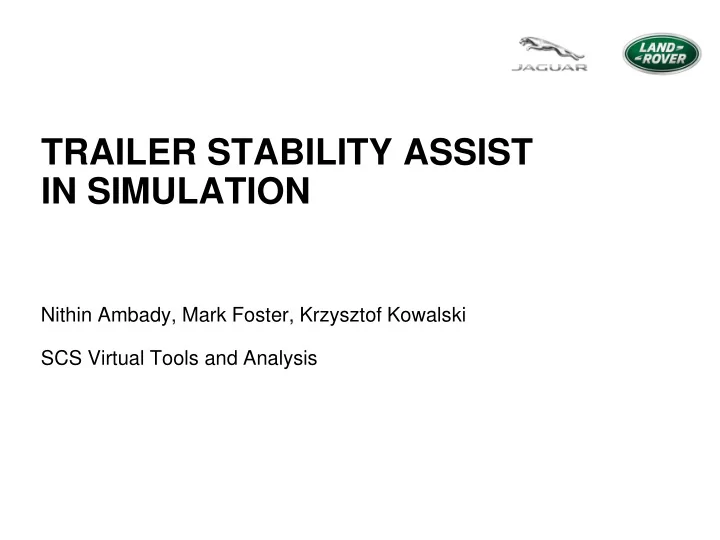

TRAILER STABILITY ASSIST IN SIMULATION Nithin Ambady, Mark Foster, Krzysztof Kowalski SCS Virtual Tools and Analysis
Introduction TSA (Trailer Stability Assist) development in simulation allows the tuning of the system to be performed using CarMaker and other software tools, removing the requirement for physical trailer towing tests. Drivers for capability: Elimination of associated risks to personnel, vehicles and test locations Programme costs reduced due to physical prototypes not being required 2
TSA – Sub Functions Overview Trailer Probability Learning Trailer Plug Detection Maximum Velocity Analysis Yaw Rate Damping Analysis Constant Driving Analysis Mass Analysis Sway Detection Sway Mitigation 3
Trailer Probability Learning – eg. Constant Run Analysis Current Method: Developed Method: • Virtual Testing • Physical Testing • 1 of each engine variant vehicle model • 1 of each engine variant vehicle required required: • Accurate engine model data • 1x 800kg trailer • Accurate aerodynamic data • Trailer ballast • Correct gearbox data (ratios, inertias and shift limits) • Dummies and vehicle ballast • Correct Torque Conveter data (ratios, • Use of Proving Ground inertias and shift limits) • Correct drive train data (Conveter • 1 Application Engineer fctors, look up logic, inertias & spring • constant) 1-3 weeks work based on Timing • 2x Trailer models required, min and max • Repeat with changes in engine calibration weights (800kg and 1800kg) (built from Trailer Builder tool) and prototype vehicle level. • Const_Run_Result TestWare script • Constant_Run_Result.m Script for post processing data and Report Generation. • 1hr per engine variant [ref: TSM in Simulation, Mark Foster, Sept 2013] 4
Vehicle Model Correlation Trailer Probability Learning Correlation Manoeuvres used: Coast Downs in Neutral 60 kph, 80kph, 120kph Constant Runs in Drive 60 kph, 80 kph, 120 kph Study: 1. Effects of Tyre Rolling Resistance 2. Effects of Aerodynamic Data 3. Effects of Wheel Bearing Friction 5
Constant Run Analysis- Vehicle Model Correlation Effects of Tyre Rolling Resistance Looking at physical coast down data (in N) for the same vehicle changes were made to the LMY scaling factor for rolling resistance inside the tire model, this was done until the 0-15km/h range is matched. Aerodynamics will not have an effect at this low speed. For this vehicle it is equivalent to 1.2. [ref: TSM in Simulation, Mark Foster, Sept 2013] 6
Constant Run Analysis- Vehicle Model Correlation Effects of Aerodynamic data Once the tyre rolling resistance is confirmed it is important to use aerodynamic data which is as close as possible to the physical vehicle. Again this is compared in a coast down from 125km/h in N. Unfortunately no aerodynamic data exists for the M1 vehicles, as can be seen from the 3 sets of aerodynamic data we have, the X250 data is closest, however it can also be seen there is still a large difference in the coast down between the model and the physical vehicle. [ref: TSM in Simulation, Mark Foster, Sept 2013] 7
Constant Run Analysis- Vehicle Model Correlation Effects of Wheel Bearing Friction Once the rolling resistance and aerodynamic data has been chosen it is important to get the overall coast down to match. As the tests we want to perform with this correlated model are all in gear and between 60-100k, it is important to correlate the coast down in D. This will also include all of the drag from the drivetrain. As such the wheel bearing friction has been introduced to generate more drag on the vehicle to represent a similar level as seen in the vehicle. The friction coefficient chosen is 0.04. [ref: TSM in Simulation, Mark Foster, Sept 2013] 8
Tools and Methods • Virtual Development of TSA using: IPG Testware IPG Test Manager TestWare Builder GUI (Bespoke JLR) Trailer Builder GUI (Bespoke JLR) Matlab m-scripts in the CarMaker for Simulink Environment Auto selection of Calibration files based on the vehicle selected Post Process data files to generate parameters 9
Tools and Methods Test Suite Creation 10
Tools and Methods Bespoke Tools 11
Conclusions It is possible to tune the function to a certain degree of confidence using just Simulation Few Hours than weeks of physical Testing Understand a broader range of Trailers, Test Speeds, Loading Conditions Elimination of associated risks to personnel, vehicles and test locations Programme costs reduced due to physical prototypes not being required 12
Nithin Ambady (nambady@jaguarlandrover.com) Mark Foster (mfost103@jaguarlandrover.com) Krzysztof Kowalski (kkowalsk@jaguarlandrover.com)
Recommend
More recommend